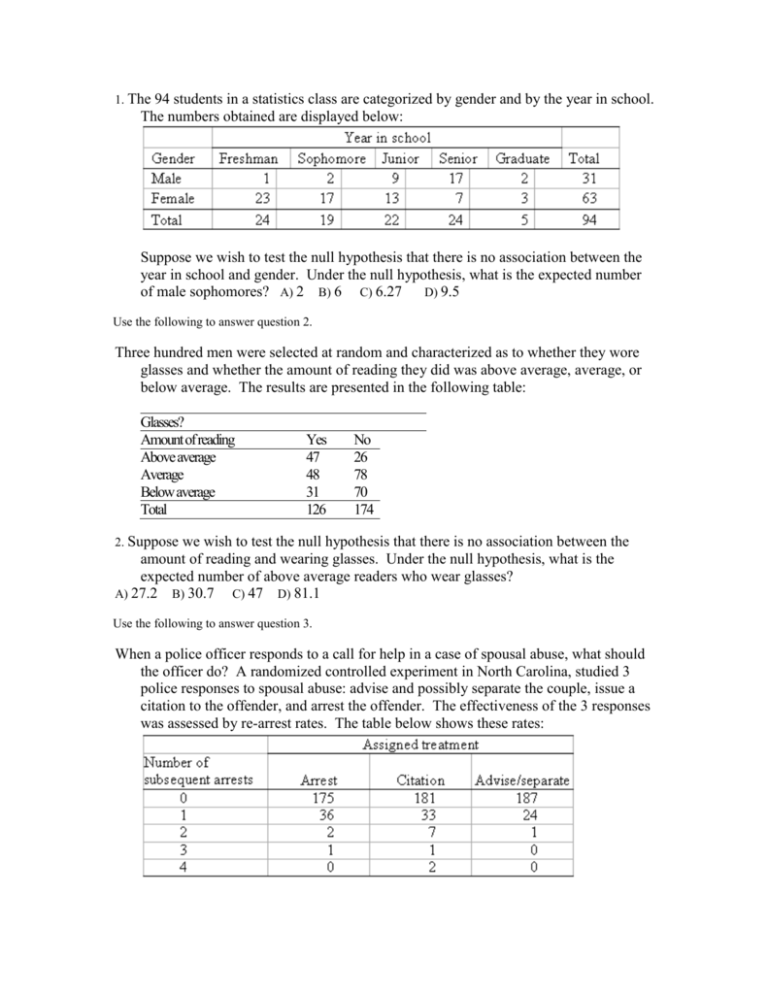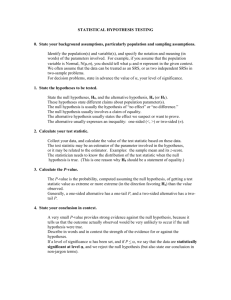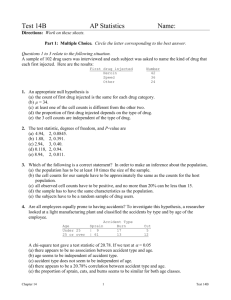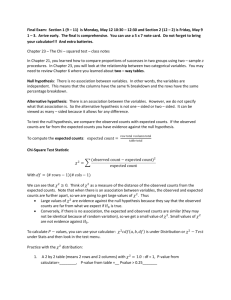suppose obtained
advertisement

1. The 94 students in a statistics class are categorized by gender and by the year in school. The numbers obtained are displayed below: Suppose we wish to test the null hypothesis that there is no association between the year in school and gender. Under the null hypothesis, what is the expected number of male sophomores? A) 2 B) 6 C) 6.27 D) 9.5 Use the following to answer question 2. Three hundred men were selected at random and characterized as to whether they wore glasses and whether the amount of reading they did was above average, average, or below average. The results are presented in the following table: Glasses? Amount of reading Above average Average Below average Total Yes 47 48 31 126 No 26 78 70 174 2. Suppose we wish to test the null hypothesis that there is no association between the amount of reading and wearing glasses. Under the null hypothesis, what is the expected number of above average readers who wear glasses? A) 27.2 B) 30.7 C) 47 D) 81.1 Use the following to answer question 3. When a police officer responds to a call for help in a case of spousal abuse, what should the officer do? A randomized controlled experiment in North Carolina, studied 3 police responses to spousal abuse: advise and possibly separate the couple, issue a citation to the offender, and arrest the offender. The effectiveness of the 3 responses was assessed by re-arrest rates. The table below shows these rates: 3. Suppose we wish to test the null hypothesis that the proportions of subsequent arrests are the same regardless of the treatment assigned. Under the null hypothesis, what is the expected number of times no subsequent arrest would occur for the treatment “Advise/separate”? A) 177 B) 181 C) 187 D) 543 Use the following to answer question 4. There are many cultural differences between the states on the continent and the island of Puerto Rico. These differences include the way consumers handle problems with purchases. Two researchers surveyed owners of VCRs in the Northeast U.S. and in Puerto Rico. They asked those who had experienced problems with their VCRs whether they complained. The results are given in the table below: Location Complained? No Yes United States 94 330 Puerto Rico 33 64 The output below includes the cell counts, the expected cell counts, and the chi-square statistic. Expected counts are printed below observed counts: Chi-square = 0.855 + 3.744 + 0.276 + 1.204 = 6.079 4. What do we know about the P-value for testing the null hypothesis that the probability of complaining is the same for the United States and Puerto Rico? A) P-value < 0.010 B) 0.010 < P-value < 0.025 C) 0.025 < P-value < 0.05 D) This cannot be determined, because these are not the hypotheses being tested by the chi-square test. Use the following to answer question 5. A specific type of electronic sensor has been experiencing failures. The manufacturer has studied 200 of these devices and has determined the type of failure (A, B, C) that occurred and the location on the sensor where the failure happened (External, Internal). The following table summarizes the findings: Location of Failure Internal External Total Type of Failure A 50 61 111 B 16 26 42 C 31 16 47 Total 97 103 200 5. Which of the following statements is (are) TRUE? A) The null hypothesis is that all the population proportions for Type of Failure are equal. B) The null hypothesis is that there is no association between Type of Failure and Location of Failure. C) The alternative hypothesis is that there is an association between the row and column variables. D) The test statistic will have 6 E) Only B and C are true. degrees of freedom. Use the following to answer questions 6-7. Revenue shortfalls led to a reduction in the state budget for higher ed. To offset the reduction, the largest state university proposed a 25% tuition increase. It was determined that such an increase was needed to simply compensate for the lost support from the state. Samples of 50 freshmen, 50 sophomores, 50 juniors, and 50 seniors from the university were asked whether or not they were strongly opposed to the increase. The results are given in the following table: Year in school Opinion Freshman Sophomore Junior Senior Strongly opposed 39 36 29 18 Not strongly opposed 11 14 21 32 6. To compare the four classes (years in school) with respect to their opinion regarding the proposed tuition increase, which distribution should we calculate? A) The joint distribution of year in school and opinion. B) The marginal distribution of opinion. C) The conditional distribution of year in school given opinion. D) The conditional distribution of opinion given year in school. 7. At the 5% significance level, what is the largest value the chi-square statistic could be, before rejecting the null hypothesis? A) 7.81 B) 9.25 C) 9.49 D) 16.92 Use the following to answer question 8. Samples of 350 women and 450 men are obtained. The 800 people in the sample are categorized as in-state, out-of-state, or no college. Location Gender In-state Out-of-state No college Total Male 166 205 79 450 Female 154 115 81 350 Total 320 320 160 800 The output includes the cell counts and most expected cell counts. Expected counts are printed below observed counts: 8. What would be the null hypothesis for a chi-square test based on these data? A) College location and gender are independent. B) The average college location is the same for men and women. C) The distribution of college location is the same for men and women. D) The distribution of gender is different for the three different college locations. Use the following to answer question 9. An insurance company has conducted a study of its claim experience and the size of the automobile involved in the accident. A sample of its claim files over the past 12 months was selected and claims were categorized according to the size of car (compact, midsize, large), and also according to the amount of damage (minor, extensive, write-off). The following table summarizes the results. Size of Car Extent of Damage Minor Extensive Write-off Total Compact 21 44 31 96 Midsize 25 52 61 138 Large 36 53 37 126 Total 82 149 129 360 9. The appropriate A) t- test, C) test in this situation and its degrees of freedom are, respectively with 8 degrees of freedom. B) test, with 1 degree of freedom. test, with 4 degrees of freedom. D) z test, with infinite degrees of freedom. Use the following to answer question 10. There is a study conducted in 1898 by von Bortkiewicz which provides data on the death of soldiers in the Prussian army from kicks by horses and mules. The data pertain to 10 army corps, each observed over 20 years, for a total of 200 corps-years. The following table summarizes the observed data: note that in 109 corps-years zero deaths occurred; 65 corps-years had one death, etc.: Deaths 0 1 2 3 4 Total Occurrences 109 65 22 3 1 200 Von Bortkiewicz felt that a distribution known as the Poisson distribution would describe these data well. Using that distribution, he produced the following probabilities: Deaths 0 1 2 3 4 Total Probabilities 0.543 0.331 0.101 0.021 0.003 0.999 10. Under the appropriate null hypothesis, what is the distribution of the test statistic? A) with 5 degrees of freedom B) with 1 degree of freedom C) with 3 degrees of freedom D) with 4 degrees of freedom Answer Key - Untitled Exam-14 1. C 2. B 3. A 4. B 5. E 6. D 7. A 8. C 9. C 10. D











